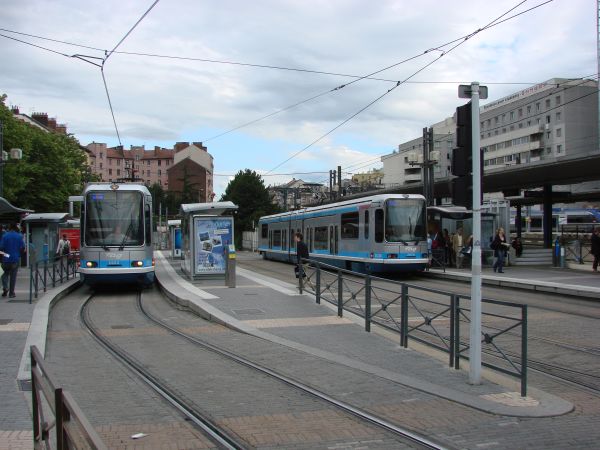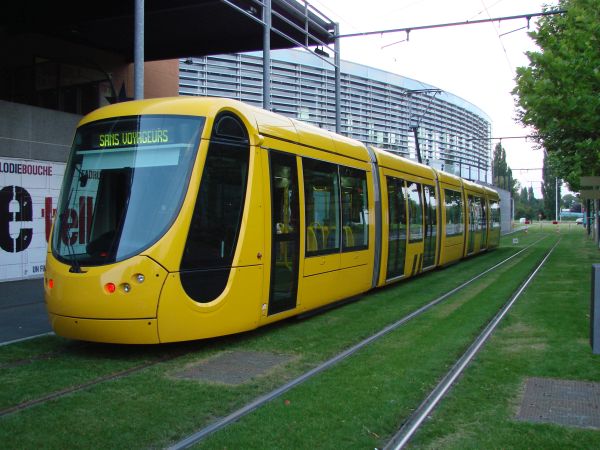
France - Trams
For a full scale picture, please click on the picture shown !
Lignes d'Azur, Nice (Nizza)

Lignes d'Azur operates local buses and trams in the Nice (Nizza) - Côte d'Azur area. There is just one tram line T1
operating between the stops called Henri Sappia at the other end and Hôpital Pasteur at the other. The trams are Alstom Citadis 302/402
models. This one is in the city center of Nice running towards Hôpital Pasteur.
Picture from Nice 8.3.2018 by Ilpo Ruissalo.
Trams of Clermont-Ferrand

The city of Clermont-Ferrand has just one long tram line called line A. And it is not a standard tram but rather a "Translohr" where just
one rail guides where the vehicle is to go. The long trams actually run on rubber tyres just like buses. Clermont-Ferrand's Translohr line
15,7 km long with 34 stops. It uses 750V DC current from regular catenary wires overhead. There are 30 of these tram wagons in the city.
Picture from near the tram stop Universités at Cours Raymond Poincare 21.10.2024 by Ilkka Siissalo.

Here the Translohr tram has now reachd a straight line track and is sppeding up the hill to cross a long bridge.
Picture from near the tram stop Universités 21.10.2024 by Ilkka Siissalo.

Each Translohr tram is 32 metres long and has a capacity of 238 people with only 40 seats.
Picture from near the tram stop Universités 21.10.2024 by Ilkka Siissalo.
Trams of Grenoble / Tramway de Grenoble

Two Alstom Citadis 402 trams near the Grenoble main railway station.
Picture 26.6.2007 by Ilkka Siissalo.

Another Alstom Citadis 402 tram arrives at the tramstop by the Grenoble main railway station.
Picture 26.6.2007 by Ilkka Siissalo.

Two Alstom Citadis 402 trams meeting by the tramstop of the Grenoble university
Picture 27.6.2007 by Ilkka Siissalo.

An Alsthom TFS tram is approaching a tram stop near Grenoble main railway station. This tram is from 1992. On the right a newer
Alstom Citadis 402 tram. (Note that in the meantime the company changed its name from Alsthom to Alstom.)
Picture 26.6.2007 by Ilkka Siissalo.

Two Alsthom TFS trams stopping in front of the Grenoble main station.
Picture 26.6.2007 by Ilkka Siissalo.
Tramway de Lyon

The public transportation system TCL of Lyon has nine tram lines numbered from T1 to T10 (T8 is missing). In addtion here is one extra
line which connects the main train station with the airport. TCL has 66 km of tram line and operates them using 73 Alstom Citadis 302 trams
and 34 longer Alstom Citadis 402 trams. This one is one of the Citadis 302 trams, built in year 2000.
Picture from the end station of line T6 at Hôpitaux Est–Pinel 21.10.2024 by Ilkka Siissalo.

A better look at the same Citadis 302 tram.
Picture from the end station of line T6 at Hôpitaux Est–Pinel 21.10.2024 by Ilkka Siissalo.

This one is one of the newer and longer Alstom Citadis 402 trams, which operate on lines T3 and T4. They are 43,8 m or 44 m long depending on
their prduction batch. The first batch entered service 2012-13 and the later one 2019-2020. This one is from the 2012-13 batch.
Picture from the Lyon main train station Lyon Part Dieu 21.10.2024 by Ilkka Siissalo.

Another picture of the same Citadis 402 tram. The tram drivers don't like this tram type because the windscreen which is supposed to be very stylish
actually causes a lot of reflections and hinders thereby proper visibility out of the trams - something which is obvious also just by looking at this picture.
Picture from the Lyon main train station Lyon Part Dieu 21.10.2024 by Ilkka Siissalo.
Lyon Rhônexpress by Systral

Rhônexpress is a private fast tram which connects the city center of Lyon with the local Aéroport Lyon Saint Exupéry airport and also with the fast TGV trains' station
which lies well outside of the city. It replaces former airport buses. Rhônexpress is operated by a company called Systral, but actually the business
has a group of owners forming a consortium including Vinci SA (28.2%), Veolia Transport (28.2%), Vossloh Infrastructure Service (4.2%), Cegelec Centre Est (2.8%) and the Caisse
des dépôts et consignations. Rhônexpress' line is 23 km long and outside the city these Swiss trams can run 100 km/h.
Picture from the Lyon main train station Lyon Part Dieu 21.10.2024 by Ilkka Siissalo.

Rhônexpress uses trams which are a short version of the Swiss company Stadler's Tango trams family,
Picture from the Lyon main train station Lyon Part Dieu 21.10.2024 by Ilkka Siissalo.
Tramway de Nancy / Stan

The tramway of Nancy's TVR vehicles are strictly speaking not trams, but rather rail-guided rubbertyred dual-mode buses composed of
three sections. They are operated by the Service de Transport de l'Agglomération Nancéienne (STAN) and therefore often also referred
to as Stans. This is Bombardier's technology which they call TVR (Transport sur Voie Réservée, transport on a reserved lane). Outside
the city center they operate as normal buses, but when the vehicle comes to the city's old town where streets are especially narrow,
the bus attaches itself to the guiding rail and also uses trolley pole masts to collect electricity in the same style that normal
trolley buses do. The Stan system began its operation in 2000. But the city is not happy with these vehicles. They are heavy and as the
rail guides these vehicles to run on exactly the same track, they quickly break the street pavement. Asphalt is not nearly as strong
as metal rails. They also derail easily. In the
city of Caen they had a similar TVR system, but Caen already gave up using it and sold their TVR buses to Nancy as a source of spare
parts. Also the city of Nancy is planning to get rid of these vehicles replacing them with traditional trams.
Picture from downtown Nancy 12.5.2002 by Ilkka Siissalo.

Stan TVRs have a large capacity thanks to their three sections. But they derail easily, especially during winter conditions when snow
packs onto the track.
Picture from downtown Nancy 12.5.2002 by Ilkka Siissalo.

In the TVR system the guiding rails do not raise up from the street level. During wintertime, snow and ice easily gets collected
and packed tightly into the rails thereby lifting the TVR bus out of its guiding rail. A three-section vehicle can move quite
uncontrollably when it derails.
Picture from downtown Nancy 12.5.2002 by Ilkka Siissalo.

The long TVR vehicles look like a crossing between a bus and a tram. But this picture shows already clearly the other problem of
the TVR vehicles tendency to break the asphalt when they run over and over again exactly on the same track. This picture was taken
in 2002 so by then the system had been in use only for some two years, but still you can easily see how the rubber tyres have left
their marks on the pavement already.
Picture from downtown Nancy 12.5.2002 by Ilkka Siissalo.

A Stan TVR vehicle in 2016. Note how the chassis has been slightly altered to more reveal the turning front wheels. As the Stan
vehicles are strictly following the same path due to the guiding rail, they could not easily avoid or run around small obstacles
such as fallen tree branches for example. They got easily stuck between the front tyres and and the chassis plates.
Picture from Nancy railroad station 16.6.2016 by Petteri Holopainen.
Trams of Mulhouse

The tram system in the city of Mulhouse in Alsace (former Müllhausen of what was German Elsass) is fairly new. The two first tram lines
were opened in 2006. Currently in 2018 there are three tram lines plus one tram-train service. This tram is an Alstom Citadis 302,
seen here in front of the Mulhouse football stadium.
Picture 17.7.2007 by Ilkka Siissalo.

Same tram as above, but seen from the other side.
Picture 17.7.2007 by Ilkka Siissalo.

Five Citadis 302 trams at the tram depot in Mulhouse.
Picture 17.7.2007 by Ilkka Siissalo.
Trams of Paris / Île-de-France

Tram lines around Paris are being developed all the time. Trams do not come to the very city center
of Paris, but in the suburbs there are more and more tram lines. This tram no.358 is one of the very new Alstom's 1435 mm gauge
trams driving on the lines T3A and T3B, which are really long lines.
Picture from Porte de la Villette 5.6.2018 by Ilkka Siissalo.

Same tram seen from behind. These new trams have driver's cabs at both ends and doors on both sides.
There are in 2018 ten tram lines in the Île-de-France area. Total network length is 104,7 km. Two lines use rubber tyre trams.
These trams on the picture are used on lines T3a and T3b. They are of the type Alstom Citadis 402 and they were ordered in 2003.
They are 43,7 metres long and 2,65 metres wide, with seven sections.
Picture from Porte de la Villette 5.6.2018 by Ilkka Siissalo.

Side view shows the remarkable length of the Citadis 402 trams.
Picture from Hôpital Robert Debré tramstop in Paris 5.6.2018 by Ilkka Siissalo.
Trams of Strasbourg

The ultramodern Eurotram low floor trams of the EU city Strasbourg are fast, they can bend at 6 joints at street
corners and they have 6 large doors on both sides of the tram. There´s a similar cockpit at both ends of the tram.
Photo in January 1999 by Ilkka Siissalo. Uploaded May 24, 1999.

